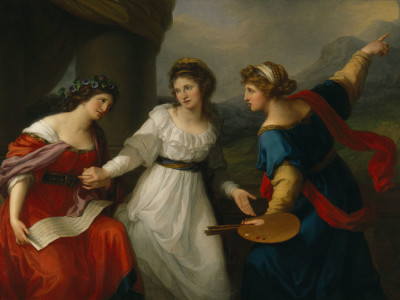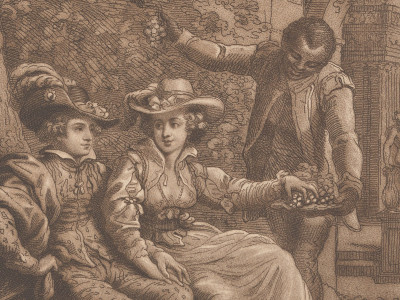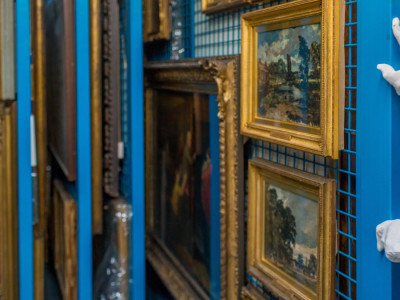
Richard Deacon: “Don't depend on other people's affirmation”
By Sandra MacKenzie
Published on 7 August 2017
Turner Prize-winning artist Richard Deacon RA talks obsessive collecting, ambiguous titles and finding the interest in everything.
Richard Deacon was nominated for the first ever Turner Prize in 1984, winning the award on his second nomination three years later. In 2014, Tate Modern staged the first major retrospective of his work. A sculpture installation made up of his selections from the RA Collection opened this summer on the Sackler Landing of Burlington House.
I’m always stuck for ideas.
It’s a blessing when you get one, because once you’ve got an idea you can go on. I have a big collection of things that I keep, but it’s more like a parallel universe – it’s never been that direct an inspiration.
There’s not much that I’m not interested in
or couldn’t become interested in. Often it's a question of context. You might find a hyperrealistic sculpture in a Baroque Spanish cathedral too much, but when you extract it to a secular context you realise that the form is interesting and there’s actually a lot going on. Equally, you can look at it the other way – when they’ve done reconstructions of Greek sculpture and applied the polychromy, then you think, “God, that’s really not very good!”
I’m a compulsive hoarder
of things I’ve found interesting. I’ve still got my schoolbooks, I’ve still got my O-Level papers. I was a very big stamp collector from the age of about five to about 15 and I’ve kept my stamps. When my father died he had a lot of photographs and inevitably, I was the one who said I would take them. I've kept a lot of things. If you’re a compulsive hoarder, then that’s what you do.
A judgement like either the Turner Prize or achieving a record price at auction shouldn’t affect your ability to enter the studio to make work. You have to disassociate price from value.
For a long time I wanted to be a farmer.
I liked being outside, that was quite important to me. Any activity that involved me being outside was okay, so I thought about being a botanist or biologist, farmer or estate manager. I studied maths and physics at A-Level, so I also considered being a physicist. It’s still part of my mental makeup, being good with numbers.
I lived in Sri Lanka for three years as a child.
My father was in the RAF. On our first day, there was a snake charmer in the market. He produced a mango stone, put it on the ground, covered it with a little pyramid of earth and put a handkerchief over the top, then used his snake charmer’s flute. The handkerchief lifted up and when he whipped it off, there was a tree underneath, leaves blowing in the wind. It seemed to me that I was somewhere special. I came back with green hair from the chlorine in the pools, though.
I’ve been a Greenpeace supporter for 40 years.
If I had to choose another career, it would've been very good to have been an environmental scientist. I’m a birdspotter – I’m obsessive about insects, animals and birds.

I was relieved not to win the Turner Prize in 1984.
I could see no good reason why I would win it against artists of much greater accomplishment [Deacon was nominated alongside Gilbert & George RA, Richard Long RA, and Malcolm Morley, who won]. To be nominated was extraordinarily good for the critical reception of my work, but to win would’ve confused me. I wouldn’t have understood why and I wouldn’t necessarily have agreed. In ‘87, I felt it was right. I’d had an exceptional year, so I was fine with that.
In the early ‘80s, I spent three days shifting five objects around a room
to get an installation right. Installing an exhibition is about attention to detail and sensitivity to position, to the way that things look, whether they interrupt each other’s sightlines. I learnt a lot from Anish Kapoor, who was always really good at it. As an artist you’re quite good anyway at attention to detail, so it’s just realising that that is a generalisable skill.
All my work is political.
In the late 80s, Bill Woodrow RA and I were both asked to contribute a work to an Art Against AIDS auction, but neither of us had anything to put in off the shelf. It seemed an interesting idea for two men to work together to contribute something, to indicate our male-to-male solidarity – it had some connection with the fight against AIDS. Although, it completely bombed at auction. They wanted stereotypical works, in order to maximise funding – our work together was outside what the market expected
It’s easier to remember sculptures when they’ve got names.
There’s a funny thing when the name fits, you bring it to mind quite easily. I’m not sure Untitled #57 easily comes to mind, whereas if the name works, in the same way that a person’s name works, it sticks.
My titles are quite ambiguous.
For example, Nothing is Allowed means that the void is permissible, but it was paired with a work called Nothing is Forbidden, which also means that the void is disallowed. It works both ways. Nothing is Forbidden is a kind of libertarian slogan, whereas Nothing is Allowed is anti-authoritarian, it’s a complaint. It has a political and social context, but, if you read it in terms of what it says, it means that negative space, or nothingness, is something that you can think about.

Nothing Is Allowed, 1994

Nothing Is Forbidden, 1994
I started teaching art history to give sculpture students some context
in the late ‘70s. I had a bit of a beef with the fact that the majority of art history was taught from the point of view of painting, and sculpture was a bit of an add-on. I thought the sculpture students were extremely badly served by art history departments. My first seminar focused on the history of 20th-century sculpture in particular. It then broadened out into a more general approach, became a bit global, and then I stopped doing it, because it would have needed too much time to do it properly.
There’s no “should” when it comes to artists knowing art history.
You can be a very bad artist that knows a lot of art history and you can be a good artist that doesn’t know any art history. You pick it up along the way. People have different relationships to art history. An artist doesn’t really look at historical objects in terms of their historical context, but more in terms of their formal interest.
I’m lucky none of my works have become million-pound sellers.
I think the auction houses can have quite a destructive impact on the way that artists can be perceived. A judgement like either the Turner Prize or achieving a record price at auction shouldn’t affect your ability to enter the studio to make work. You can start believing all sorts of crap about yourself. You have to disassociate price from value. It doesn’t derail you, but it does affect the way that people deal with you.

Democratic Process – from the series Deacon/Woodrow, 1990

Let's Not Be Stupid, 1991

After, 1998

Associate, 2014
I refused the Royal Academician nomination once.
At the time I thought the Royal Academy didn’t serve the interests of contemporary artists particularly well. In the intervening years it reorientated itself and became a more interesting institution, a more welcoming institution. It’s kept on that path since.
I don’t have any hesitations putting my work online.
I’m alive, so if people want pictures and they ask me, I’ll give them. I think it’s more in my interests to spread, and to allow reproductions and to be supportive. I’ve just rebuilt my website. There’s lots of digital stuff and augmented reality stuff which is going to be really interesting for the ways in which we experience art and the ways we come across it.
Only ever ask for things when you know the answer is going to be yes.
My advice for young artists is to never put yourself in a position where someone can say no. Do things for yourself, try to work it out and don’t be dependent on other people’s affirmation or rejection – because once people have said no, it’s very hard to get them to change their minds.
Richard Deacon RA Selects is open now in The Dame Jillian Sackler Sculpture Gallery. Download Smartify from the Android or Apple app store before your visit to listen to Richard Deacon discuss the works in the exhibition.
Related articles

The meteoric rise of Angelica Kauffman RA
2 January 2024

Untold Stories
26 October 2023
